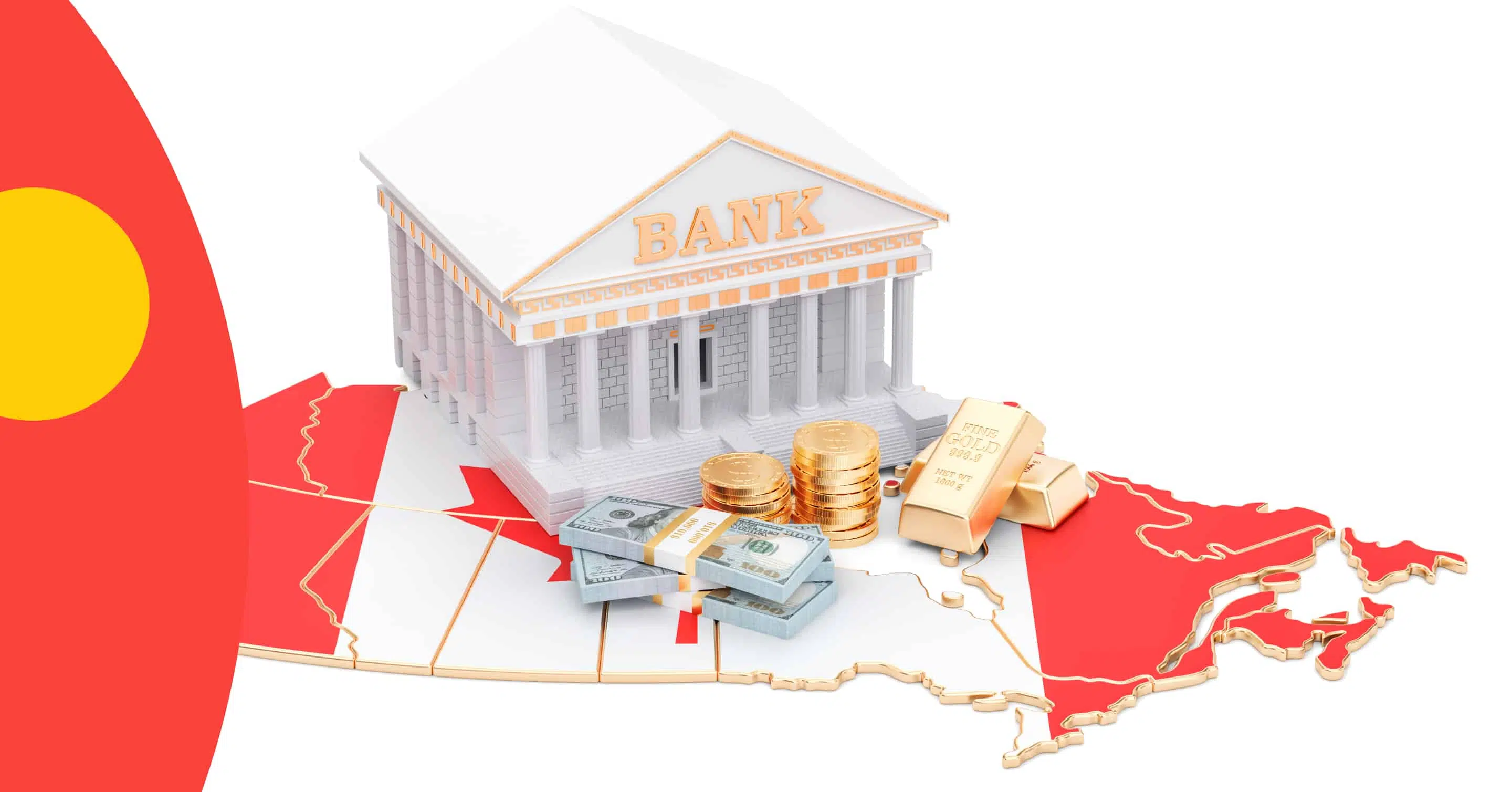Bank of Canada Interest Rate

The Bank of Canada (BoC) carries out monetary policy by influencing short-term interest rates. It does this by adjusting the target for the overnight rate on 8 fixed dates each year.
Key Takeaways
- As of January 6, 2026, the Bank of Canada’s key policy rate is set at 2.25%.
- The fluctuating key policy rate is the central bank’s main tool for stimulating or slowing economic activity in response to market factors like inflation.
- The key policy rate has a variance of 2.20% from the prime rate, which directly affects all other lending interest rates.
Skip reading, watch and learn about all things Bank of Canada Interest Rate below 👇
What Is the Bank of Canada?
The Bank of Canada is the country’s central bank. It was officially founded in 1935 and is designed to regulate and maintain Canada’s financial system and economy. Officially, through the Bank of Canada Act, its main undertaking is “to promote the economic and financial welfare of Canada.”
The Bank is also responsible for Canada’s monetary policy. It primarily does this by setting what’s known as the target overnight rate, which is more aptly known as the key policy rate. The BoC can influence the money supply by changing this rate to help regulate the Canadian economy. The Bank of Canada is also responsible for issuing Canadian currency, managing foreign currency reserves, and supervising financial systems, funds transfers and retail payment systems through its various departments.
Bank of Canada Key Policy Rate Stands at 2.25%
In March 2020, the Bank of Canada lowered its policy rate to 0.25%, where it remained until March 2022. Since then, the Bank of Canada has raised interest rates a total of 10 times, bringing the rate to 5.00%.
After a long period of historically low rates, in 2022, the Bank of Canada introduced the April, June, July and September rate hikes to tackle a superheated Canadian housing market and surging inflation. July 2022 was the single largest rise in the key policy rate since 2000 (typically, rates increase around 0.25% each time), but July saw an oversized hike of 1%.
The Bank of Canada decreased rates for the first time since 2020 at the June 5th, 2024 announcement. This was mostly expected as economic growth slowed and inflation eased. Given the economic outlook, the Governing Council lowered the policy rate by 25 basis points to 4.75%.
What Is the Target Overnight Rate?
The Target Overnight Rate, also known as the Key Policy Interest Rate, is the primary tool used by the Bank of Canada (BoC) to control inflation domestically. Making it the starting point for setting many interest rates across the Canadian economy. The Consumer Price Index primarily measures inflation.
The Target Overnight Rate doesn’t directly affect the general public, but it does affect the overnight market. The overnight market is how Canadian Financial Institutions settle payments and funds transfers at the end of each business day. Each day, clients at various banks and credit unions transact through bill payments, debit, and other transfers.
All these transactions will need to be settled between them – even international wire transfers settling through correspondent arrangements made at one of the Canadian Financial Institutions. While some may have a net deficit between their transfers – these institutions will borrow money from each other through the central bank at the overnight rate on the overnight market. The central bank sets the target overnight rate as a ‘target’ for the amount financial institutions should charge in interest when lending these overnight loans – aptly called the target to the overnight rate.
Bank of Canada Overnight Rate Changes Since 2010
For the last 12 years, the key policy rate has gone no lower than 0.25%. For over half of 2020 and all of 2021, the BoC’s Key Policy Overnight Rate remained at 0.25%. At the time of this update, the rate sits at 2.25%.
Bank of Canada Overnight Rate Forecast – 2024
In October 2022, the Bank of Canada took a 45-degree turn, saying that one of its core inflation measurements, CPI-common, may be broken. The flaws showed up when rates surged so quickly. CPI-common is a measure of core inflation that tracks common price changes across categories in the CPI basket. It uses a statistical procedure called a factor model to detect these common variations, which helps filter out price movements caused by factors specific to certain components.
The central bank has concluded that it will remove CPI-common from its inflationary measurements, thus raising expectations of further rate hikes with the new modelling. The BoC Governing Council remains divided on whether rates must increase further to curb inflation. However, economists believe we won’t see any more increases to the policy rate and may see rate cuts as early as Q2 2024.
Based on the median response, the most recent Bank of Canada (BoC) Market Participant Survey forecasted the first rate cut occurring in June 2024. This survey gathers and publishes the views of senior economists and strategists in the Canadian financial market.
As long as inflation continues to trend in the right direction, another 25 basis point rate cut is forecasted to occur at the July announcement.
Get approval on your low rate today
No big bank bias, just commission-free experts ready to help you.
Bank of Canada Overnight Rate History
The Bank of Canada was Created in 1935
After the Great Depression in North America, the Bank of Canada Act was introduced towards the end of 1934. The Bank of Canada was founded the following year in response to the economic fallout of the Great Depression. In March 1935, the Bank of Canada was opened to public investors, and shortly after, it was nationalized as a crown corporation in 1938.
1935 – 1945: The Great Depression and World War II
The Great Depression was a global social and economic crisis in the early 1930s. Canada, in particular, was badly affected by high unemployment, bankruptcy and homelessness at the time. The Bank of Canada’s interest rate began at 2.5% in 1935. By the end of World War 2, it had dropped to 1.5%, and the economy had strengthened significantly during the war.
1945 – 1955: The Post-War Period
The Bank of Canada rate did not rise again until October 1955, when it increased to 2.0%. In the wake of the Second World War, the Canadian economy developed considerably, particularly in the primary sector (raw materials) and secondary sector (manufacturing). The low interest rates after the war helped Canadians invest in infrastructure, housing, and consumer goods.
1977 – 1991: Stagflation
Generally, unemployment and inflation have an inverse relationship. When more people are employed, inflation is generally higher as spending increases overall. Stagflation is a term in economics that describes a situation where both unemployment and inflation are high, alongside slowing economic growth (sound familiar?).
After a period of sustained growth after the war, the Bank of Canada rate continued to experience trend growth until the 1980s, when it finally peaked at 20.03% in August 1981, an all-time high since the Bank’s inception. After this, the rate fluctuated between 15% and 7.5% in the late 1980s and early 1990s.
1991 – 2008: Economic Recovery
Since the early 1990s, the Bank of Canada rate has trended downwards, with some periods (e.g., the late 1990s) in which the rate spiked before gradually falling again. The Canadian government introduced Target inflation figures in 1991, which have been reviewed periodically since then (currently set at 2%).
2009 – 2017: The Financial Crisis
The 2007-2009 financial crisis resulted from years of cheap credit and relaxed lending standards that fueled a housing bubble, which eventually burst, resulting in major financial institutions in North America being left with trillions of dollars of toxic debt in the form of subprime mortgages. The Bank of Canada immediately lowered the key policy rate in response to the collapse, down to 0.5% in March 2009, the first time the rate had ever fallen below 1%. Since then, the rate has hovered within roughly 0.75% of the 1% mark.
2018 – 2021: COVID-19
Before the global pandemic, the Bank of Canada’s rate held steady at around 1.75%. Over 11 days in March 2020, the pandemic in North America began, and the rate was lowered by 150 basis points (1 basis point equals 0.01%) from 1.75% to 0.25%, in step with our US counterpart, the Federal Reserve (Fed).
2022 – 2023: Inflation
Rates remained at this historic low until March 2022, at which point they started to be hiked again to tame growing inflation. There was a 25 bps (1 bps equals 0.01%) increase in March and another 50 bps in April, bringing the rate to 1.00%.
In their April 13 release, when the 1.00% rate was introduced, the Bank of Canada started their quantitative tightening (QT) by stating, ” With the economy moving into excess demand and inflation persisting well above target, the Governing Council judges that interest rates will need to rise further.”
In June 2022, the overnight rate was increased again by 50bps, bringing it to 1.50%. July of this year saw a supersized increase of 100bps, bringing the target to the overnight rate at 2.50%.
Inflation continued to rise, reaching 8.1% year-over-year in June, following a 7.7% gain in May. The increase was the highest annual change since January 1983. The increase in June was broad-based but mainly due to higher fuel prices.
As forecasted by the markets, once again, the Bank of Canada raised the target for its overnight rate by 75bps to 3.25% in September 2022. Policymakers have said that interest rates will need to rise further given the inflation outlook, with surveys suggesting that short-term inflation expectations remain high. Adding that the Canadian and global economies are evolving broadly in line with their July projection and that COVID-19 outbreaks, ongoing supply disruptions, and the war in Ukraine continue to dampen growth and boost prices.
To round out 2022, two more 50 bps (equal to 0.50%) rate hikes occurred in October and December, with the policy rate at 4.25% at the end of the year.
In 2023, the Bank of Canada implemented a 25 bps (0.25%) hike in 3 of its rate announcements. The policy rate sits at 2.25% to end the year.
According to the Consumer Price Index, inflation came in at 3.1% for December 2023, and economists expect that the Governing Council will continue its rate pause as the economy continues to slow.
Frequently Asked Questions
Why is the Bank of Canada’s Target to Key Policy Overnight Rate Important?
The Bank of Canada’s main tool to control inflation is the target overnight rate—also called the policy interest rate or key interest rate. This is the starting point for many of the economic interest rates that matter to Canadians, like mortgage interest rates. Ultimately, the Bank uses the key policy rate to pull down or help increase interest rates to regulate inflation and economic activity.
Think of the target overnight rate as the brakes or accelerator on the economy. When inflation rises above the government’s target of 2%, the Bank raises the policy rates and applies the brakes to reduce spending. When inflation falls too low (which can also have negative consequences), the bank steps on the gas and lowers interest rates, helping stimulate economic spending.
Why Doesn’t the Bank of Canada Issue Negative Rates?
Negative interest rates are an unorthodox form of monetary policy where interest rates fall below 0%. This means borrowers will be credited interest instead of paying it to lenders. An issue with negative interest rates is that banks cannot pass on the cost of the negative rate to their customers. Such a policy can cause issues in the market, and as a result, the governor of the Bank of Canada has decided against using negative rates for now.
Japan has been using negative interest rates since 2016, creating stagnant consumer prices and deflation, stifling wages and corporate investment, and severely affecting its economic growth. However, in a 2015 paper on Negative Policy Rates by the Bank of Canada, the author argues there is little evidence to suggest negative rates create significant market volatility or disruption and has cited the examples of several banks (notably in Europe) that have used the policy with some effectiveness. Ultimately, though, the author suggests that more time is needed to study the overall impacts of negative rates.
How Does the Overnight Rate Work?
The Bank of Canada sets the overnight rate as a target for the amount of interest that financial institutions should charge each other in interest when borrowing and lending to balance their transactions at the end of each business day.
The overnight rate stimulates the economy by promoting spending when inflation is low or reducing spending when inflation is high. Generally, increases in the target overnight rate have a knock-on effect on the public. Financial institutions will increase their interest rates – like those on mortgages – in response to a rise in the Bank of Canada’s key policy interest rate.
How Often Does the Overnight Rate Change?
The Bank of Canada (BoC) carries out its monetary policy by adjusting the target to the overnight policy rate on 8 fixed dates each year.
Final Thoughts
The Bank of Canada target overnight rate, otherwise known as the key policy rate, or more colloquially, the Bank of Canada interest rate, is an important fiscal policy instrument. It can be considered the central interest rate for other financial institutions that borrow money from the government’s central bank.
The key policy rate influences several other rates, such as savings rates and, most importantly, mortgage rates. While several factors influence mortgage rates in Canada, the overnight rate has a significant impact.
With rates expected to remain stable until the middle of 2024, now could be the right time to lock in the best mortgage rate possible. Get in touch with our team to learn more and have our commission-free expert and qualified mortgage advisors find the best mortgage solution for your unique situation.
Ready to get started?
In just a few clicks, you can see our current rates. Then apply for your mortgage online in minutes!



